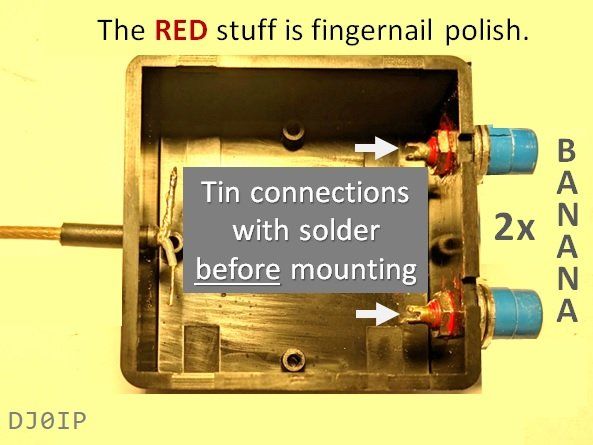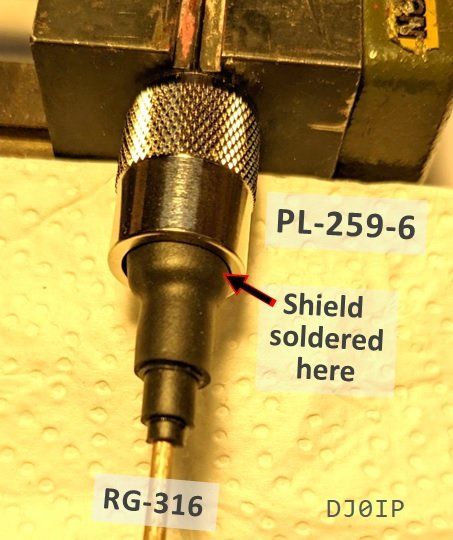A 200 Watt TUNER BALUN for 40-10m
The balun described on this page is designed to be used with an asymmetrical (unbalanced) antenna tuner (matchbox) such as a T-Network or L-Network, for matching antennas fed with balanced feedline (i.e., Ladder Line, Window Line).
Contrary to what many people wrongly believe, a tuner balun should be a 1:1 current balun, NOT a 4:1.
This has been explained by several experts including Steve Hunt, G3TXQ (SK) and Tom Rauch, W8JI.
You can find links to their explanations for this at the bottom of my web page, here: TUNER BALUNS
This specific balun was designed for a friend to be used for matching a Triple-Leg and/or a 14m long center-fed Doublet, each fed with balanced feedline (300 Ohm Window-Line). Both are non-resonant, multi-band antennas that must be matched on each band. Of course this balun will also work with 450 Ohm or 600 Ohm feedline.
The balun is mounted into a small enclosure. The OM plans to use it for portable work, running 100 Watts SSB. His tiny ATU is rated 125 Watts PEP. If he ever get interested in using digital modes, he must only remove the cover of the balun, allowing the heat to escape.
THE BALUN itself is a 1:1 Guanella (current) balun with 11 turns of Teflon-insulated, silver-plated, solid 18-AWG (1mm) copper wire, cross-wound (W1JR / Reisert method) onto a Ferroxcube T36/23/15-3S4 Toroid (beginning permeability: 1700).

Size: 6 x 6 x 3 cm - 2.4 x 2.4 x 1.2 in.
Weight: 120 g - 4.2 oz
The coax is 10 cm (4 in.) long.
Normally, for 200 Watts (SSB/CW), Teflon-insulated coax is not required. RG-58 or even RG-174 would work just fine. After all, it is a very short coax (10cm / 4in.)
However, as you will see in the 3rd picture in the photo gallery below, the shield is soldered to the casing of the PL-259-6. In order to solder to the casing, it must be heated well using a large soldering iron. When doing so with normal coax the insulation on the coax melts. There is no problem when using Teflon-insulated coax.
Because RG-316 is so thin, I first slipped a piece of heat-shrink tubing over it. I use tubing with glue inside, which prevents the tubing from later slipping on the jacket of the coax. See first photo in the gallery below.
As you see in the second photo, the casing was tinned before inserting the coax into it. This makes soldering the shield to the casing much easier.
The third photo shows how the shield is folded first back over the coax, and then after screwing the connector onto the coax, it is folder again back over the rear of the casing. After soldering, allow plenty of time for the casing to cool down before touching. (My thumb is still healing.)
I chose to use a pair of banana jacks for connecting to the balanced feedline (fourth photo). I tinned the tips of the jacks before inserting them through the plastic case. This enables me to solder the wires to them more quickly, avoiding melting the plastic.
Photos 5 & 6 show the special PL-259-6 that I use when working with thin coax (incl. RG-58). It's casing has a 6mm hole on the back. This avoids having to use an adapter from 10mm to 6 or 5mm. I have never found a source for these special connectors outside of Germany. I learned long ago to only use PL connectors with Teflon-insulation inside. The others melt too quickly. The connectors I use have a gold-plated center contact. The heat-shrink tubing (with adhesive inside) provides additional strain-relief.
The 7th photo shows the finished balun. Here you see that I used Teflon-insulated twisted pair wire instead of bifilar. Bifilar will work just as well. I find it easier using twisted pair rather than constructing bifilar feedline; especially since I buy the wire already twisted.
NOTES:
- It is important to keep the coax stub between the balun and the antenna tuner very short! People often make it 10 ft. long or longer, to avoid running balanced feedline inside the house. This is a very bad idea. The loss on 10 ft. of coax due to high SWR can be extremely high!
- The balun is good for 200 Watts, but then you should use thicker coax to the tuner (i.e., RG-58 or RG-303).
PHOTO GALLERY:








